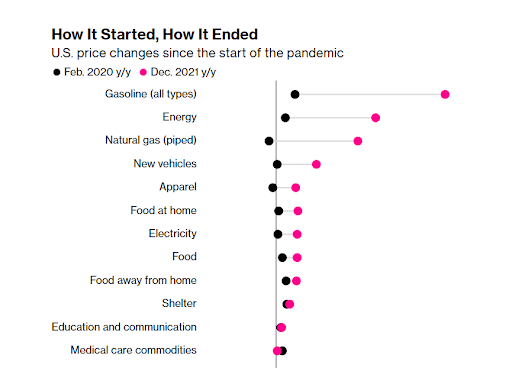Inflation and Rising Energy Costs
If you’ve been to the grocery store, or filled up your car at the pump, you’ve felt the sting of inflation. Gasoline prices alone have surged beyond 50% since last year. Small businesses are particularly vulnerable as their costs increase with no relief in sight. Inflation is at historic highs, not witnessed since the early 80’s, and the current geopolitics of oil and gas markets fuel volatility and price uncertainty. Think of inflation like a tax, yet in today’s climate, it’s accelerating much quicker than our income.
But what are the true drivers of inflation? What can consumers spending more than 8% of their household income on energy do to manage these inflating costs?
 Rising Energy Costs Fuel Inflation
Rising Energy Costs Fuel Inflation
Energy was the lead driver of inflation in 2021, with costs rising 29% from 2020. Price hikes are not just felt at the pump–as noted by the IEA, electricity bills are also rising alongside fossil fuel prices. As energy costs continue to climb, consumers should consider some low cost home energy savings. Additionally, as a nation, we should look to alternative energy sources as a way to reduce medium to long term costs and enhance community and grid resilience.
Low-Cost Steps to Home Energy Savings
An initial step towards efficiency and energy savings is to conduct an energy audit of your home. A home energy audit is typically conducted by an efficiency expert and consists of a series of tests designed to pinpoint air leaks, test insulation levels, and gauge the efficiency of your home’s heating and cooling systems. Homeowners can also perform visual inspections for immediate gaps and quick savings. Implementing the recommended (or observable) changes to your home could reduce energy use up to 30%.
A step further includes home energy management systems (HEMS), which offer instant savings and allow homeowners to monitor their major consumption sources (HVAC, water heater, major appliances, etc.) and reduce costs. These systems are essentially software platforms that allow users to monitor both usage and production (included with solar systems). They also let users control, automate and schedule the use of energy within a household in order to save money and reduce waste. HEMS like Sense or Emporia Energy are rapidly gaining popularity with a range of options to better understand and optimize home energy. Innovative utilities such as Bandera and a few others even offer plans whereby homeowners become prosumers and monetize virtual energy systems.
The Energy Transition Offers Solutions
While making your home more energy efficient is an important way to save money and be more sustainable, it doesn’t fully shield us from US inflation and rising energy costs. The energy transition from fossil fuels towards solar and storage (including EV) offers immediate savings and a range of impactful solutions.
Oil and gas are especially volatile commodities, and our long-standing dependence is a primary driver of the price spikes we continue to experience. This volatility further results from some noteworthy factors; natural resources are limited with increasing costs of extraction, and global energy markets are easily and often manipulated, sometimes even for political gain. The current conflict in Ukraine highlights the vulnerability energy markets suffer from geopolitics: global oil prices skyrocketed to more than $100/barrel as Russia began its invasion. Climate change is also a driver of oil and gas volatility. Ironically, burning fossil fuels releases a range of contaminants into the air, accelerating the shifts in weather patterns and increased risk in upstream production. . Volatile energy prices have yielded record profits for many traditional energy executives and shareholders, while the average Americans deal with the fallout and grid uncertainty Texans witnessed last year.
How Renewable Energy is Inherently Deflationary
In response to US sanctions against Russian oil, fossil fuel advocates have called for increasing domestic production of oil and gas as a way of boosting supplies. This solution is short sighted, takes time to implement, and is increasingly difficult to finance. A long term, pragmatic approach to energy-exacerbated inflation is to accelerate alternative energy solutions immediately.
Alternative energy offers solutions to stabilize power prices across the planet. Unlike oil and gas, which are commodities pegged to natural resources, solar has evolved to reach commercial scale thanks to 50 years of technological innovation. In most cases, alternative power generation and storage will continue to reduce costs and gain efficiency. Increasing the mix of solar, wind, and hydro will stabilize energy because they have fixed costs with immunities to inflationary pressure. The wind and sun are renewable, and importantly, they are locally generated and thus less sensitive to geopolitics. Unlike fossil fuels, which are locked in a few key regions, alternative energy is widely distributed and can create locally sourced energy for the 80% of the world living in fossil fuel importing countries.
Centering our electric grid around more affordable access to alternative energy is key, and work is actually well underway. Solar, wind, storage and EV infrastructure increase at record growth every year. These cleaner alternatives will be harnessed to interact with increasingly smart homes and local energy. Building an economy fueled by local jobs, emerging career pathways and a shared mission of resilient grids and connected communities creates stability. We can all agree that today affordable and predictable energy is available. It’s time for us to decouple from impacts of energy inflation and Take Your Power Back!
































Leave A Comment